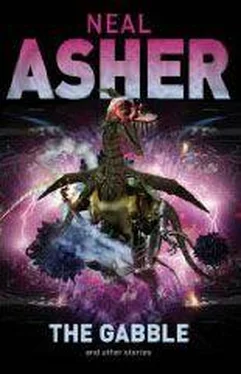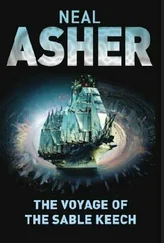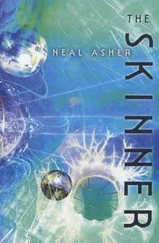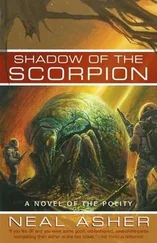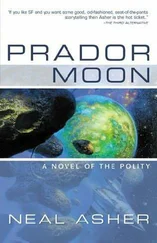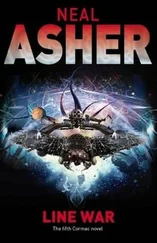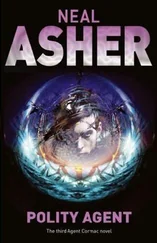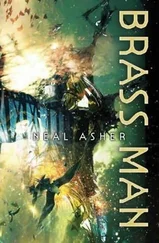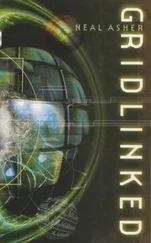Neal Asher - The Gabble
Здесь есть возможность читать онлайн «Neal Asher - The Gabble» весь текст электронной книги совершенно бесплатно (целиком полную версию без сокращений). В некоторых случаях можно слушать аудио, скачать через торрент в формате fb2 и присутствует краткое содержание. Год выпуска: 2011, Жанр: Фантастика и фэнтези, на английском языке. Описание произведения, (предисловие) а так же отзывы посетителей доступны на портале библиотеки ЛибКат.
- Название:The Gabble
- Автор:
- Жанр:
- Год:2011
- ISBN:нет данных
- Рейтинг книги:4 / 5. Голосов: 1
-
Избранное:Добавить в избранное
- Отзывы:
-
Ваша оценка:
- 80
- 1
- 2
- 3
- 4
- 5
The Gabble: краткое содержание, описание и аннотация
Предлагаем к чтению аннотацию, описание, краткое содержание или предисловие (зависит от того, что написал сам автор книги «The Gabble»). Если вы не нашли необходимую информацию о книге — напишите в комментариях, мы постараемся отыскать её.
The Gabble — читать онлайн бесплатно полную книгу (весь текст) целиком
Ниже представлен текст книги, разбитый по страницам. Система сохранения места последней прочитанной страницы, позволяет с удобством читать онлайн бесплатно книгу «The Gabble», без необходимости каждый раз заново искать на чём Вы остановились. Поставьте закладку, и сможете в любой момент перейти на страницу, на которой закончили чтение.
Интервал:
Закладка:
‘I never thought this operation short of funds,’ I say.
‘Energy is money and there’s none of the former here. It costs fifteen hundred shillings a minute to keep one human alive and comfortable. We have over two thousand personnel.’
I walk up beside him and focus on what has now caught his attention. Machines for moving rock and ice are busily gnawing at the frozen crust out there. Floodlights bathe something that appears a little like a building site.
‘Found an entrance right under our noses,’ he tells me.
‘Lucky,’ say I.
He turns to me with an expression tired and perhaps a little irrational.
‘Lucky?. . Oh yes, you’ve been in transit. You haven’t seen the latest survey results. You see, we were having a bit of a Schrodinger problem with the deep scanners. The energy of the scan was enough to cause fluorescence of the water ices down there, full-spectrum fluorescence. It was like shining a torch into a cave and having the beam of that torch turn on a floodlight. We saw only a fraction of it until we started using those low-energy scanners.’
‘A fraction?’ I say. ‘Last I heard you’d mapped twenty thousand kilometres of tunnels.’
‘That’s nothing. Nothing at all. They’re everywhere you see. Yesterday Duren told me that they even go under the frozen seas. We’re looking at millions of kilometres of tunnels, more than a hundred million burial chambers with one or more sarcophagi in each.’
I absorb this information in silence, slot it in with a hundred other details I’ve been picking up right from Farstation Base to here.
‘Obviously I want to see one of the sarcophagi,’ I eventually tell him.
He glances at me.
‘See and touch it I would have thought. Unfortunately you don’t get to smell anything. Too cold for decay here,’ he says.
‘Seeing and hearing are the most important,’ I reply. ‘Most people don’t go for full immersion for a documentary. There are much more enjoyable FI entertainments.’
‘Okay, get yourself settled in and we’ll run you down in an hour or so. Will you be needing any of your equipment off the shuttle?’
‘No, I have my eyes and ears,’ I reply.
He studies me, his inspection straying to the aug nestled behind my right ear. He seems too tired to display the usual discomfort of those confronted by a human recorder like myself.
The tunnels resemble very closely the Victorian sewers of Old London on Earth. The bricks are made of water ice and are, on the whole, over three quarters of a million years old. A strange juxtaposition of age and impermanence. Just raise the temperature and all the tunnels will be gone. Of course, the temperature will not rise here for many thousands of years. Duren, who walks with me to the first chamber, is distracted and gloomy. I have to really push to get anything out of him. Finally he comes out with a terse and snappy summation.
He tells me, ‘It will keep on getting colder and colder, but not constantly so. Every eight hundred years we get the Corlis conjunction and the resultant volcanic activity. In about a hundred thousand years Corlis will fall in orbit round here and all hell will break loose for a time.
The volcanic activity will destroy all these tunnels, melt all the ice. That’ll last for a few hundred years then things will settle down and freeze again.’
‘So future archaeologists will have to dig the sarcophagi out of the ice?’ I ask.
He waves his hand towards a side chamber and we duck into there. The lights inside are of a lower luminescence than those outside. They don’t want the light damaging things, apparently.
‘Doubt that. Hundred thousand years and we’ll know all we need to know about this place. We’ll let them sleep in peace then.’
I study him and try to figure the tone of his voice. It is too difficult to read his expression through his coldsuit mask, though.
The sarcophagi are metallic chrysalids averaging three metres in length. I say metallic because they appear to be made of brass. I am told that they were made of something very complex that does have as its basis some copper compounds. I ask if it is organic. I am told no, it is manufactured — it isn’t complex enough to be organic.
There are two sarcophagi in the chamber. One off alone, untouched and easily viewed, the other so shrouded in scanning equipment, I don’t know it is there until Duren tells me I can look inside.
No one has yet opened a sarcophagus, simply because there is not a lot more to be learned that has not already been learned by scanning. Inside each sarcophagus, suspended in water ice that is thick with organic chemicals, is an alien. These aliens are frightening. What is most frightening about them is how closely they resemble us. They have arms and legs much in proportion to our own. Their bodies are longer and wasp-waisted, their feet strange hooked two-toed things, and their hands equally strange, with six fingers protruding from all sorts of odd points, and no palms. Their heads. . how best to describe their heads? Take an almond and rest it on its side, expand it only where the neck joins it, hang two sharp barbs at the nose end and back from that punch a hole straight through for eyes … It is theorized that they had used some kind of sonar sense. This is one of the theories.
When the first sarcophagus was found people started to bandy about phrases like
‘parallel evolution’ while others claimed credence for their own pet theories. Those of a religious bent called the discovery proof of the existence of God, though the selfsame people had heretofore claimed that the discovery of no humanlike races had also been proof of the existence of God. Some claimed the discovery evidenced ancient alien visitations of Earth, whilst still others talked of interstellar seeding. How so very personal, human and petty is each theory.
Coming to make my documentary about the catacombs of Orbus and the passing destruction of the moonlet Corlis I have not thought which of them to give credence.
‘Do you think it’s parallel evolution?’ I ask Duren as I peer through the scanner.
‘Does a scorpion look like a human? It evolved under the same conditions and even on the same planet,’ he says, and totally destroys the parallel evolution argument.
‘What about interstellar seeding?’
‘Same arguments apply,’ he replies, and of course they do.
‘God?’ I ask.
He laughs in my face then says, ‘I try to understand it. I don’t try to cram it in to fit my understanding.’
He definitely has the essence of it there.
I hesitate to call this my first night here as there is little to mark the change from day to night.
You could go outside and spot the sun in the sky, but as Orbus revolves about it once every three solstan centuries that wouldn’t be much help. The personnel at the base work a shift system. My waking period concurs with that of Duren, Jap, and about five hundred others who I have yet to meet. After a night of mares in which I am chased down Victorian sewers by subzero rats I wake to a day of subterfuge and obfuscation. Something has happened and people either don’t know or don’t want to tell the nosy bastard from the Netpress. I use the most powerful weapon in my armoury to get to the bottom of it. Jap takes my bribe.
We don coldsuits in the ball-shrinking coldlock and step on out. Jap leads me to one of the tracked surface cars they call a crawler and we motor over to the nearby excavation. I still find it difficult to take in that the treads of the vehicle we ride in are made of doped water ice.
The whole idea of using such a substance makes me see our civilization as so delicate, so temporary. I guess my objection is that this is the truth.
The excavation is a tunnel that cuts at thirty degrees through rock and ice into the side of one of the Victorian sewers. This is the way I had come yesterday with Duren to view the body, so to speak. We climb out of the crawler and Jap approaches a suited figure who is walking up from the slope.
Читать дальшеИнтервал:
Закладка:
Похожие книги на «The Gabble»
Представляем Вашему вниманию похожие книги на «The Gabble» списком для выбора. Мы отобрали схожую по названию и смыслу литературу в надежде предоставить читателям больше вариантов отыскать новые, интересные, ещё непрочитанные произведения.
Обсуждение, отзывы о книге «The Gabble» и просто собственные мнения читателей. Оставьте ваши комментарии, напишите, что Вы думаете о произведении, его смысле или главных героях. Укажите что конкретно понравилось, а что нет, и почему Вы так считаете.
